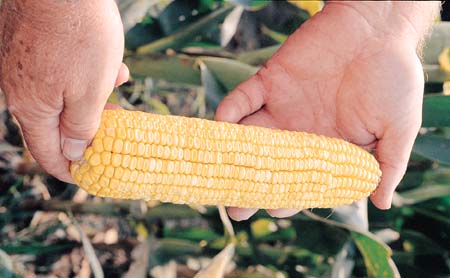
Page created by Dustin Murrell.
Corn can be sepreated into many different types of corn, depending of the characteristics of their seeds.
Dent corn, getting its name from the dent in the crown of the seed, is grown more than any other type of corn. Millions of tons of grain are produced from dent corn, and is used for human and industrial use, and for livestock feed. The starch reaches the summit of the seed, and the sides are also starchy. The denting is caused by the drying and shrinking of the starch. The dent corn grown in the Corn Belt came from a mix of New England flints and gourseed (an old variety of corn grown by the Indians in southeaster North America).
Flint corn kernals are hard and smooth and have little soft starch. Columbus and his followers reaches some countries that grew a lot of flint corn. Thus, flint was probably the first corn Europeans ever laid eyes on. Flint corn is not grown in the United States as much as it is in Asia, Central America, Europe, and South America. In temperate zones, flint corn matures earlier, has better gemination, and the plant vigor is earlier than in dent.
Popcorn is an extreme form of flint. It has a very small proportion of soft starch. It is a very minor crop, and is gown mostly for humans to eat. The reason is "pops" so well, is because of the horny endosperm, which is a tough, stretchy material that can resist the pressure of steam, which is generated in the hot kernal until it has enough force to explode or "pop."
Flour corn contains a lor of soft starch, and has almost no dent. Though it is not used much anymore, it is grown in the drier sections of the US an din the Andean region of South America. It's an older type of corn, and is found in a lot of graves of the Aztecs and Incas. Since the kernal is so soft, the American Indains could make it into flour.
Sweet Corn has an almost clear, horny kernal when it is still young. The kernals become wrinkled when dry. The ears can be eaten fresh, or can be stored in cans. The only difference between sweet and dent corn, is that sweet corn has a gene which prevents some sugar from being converted into starch. It is grown a lot as a winter crop, in the sourther US.
These kernals appear waxy. Chemically, it has a different type of starch than normal corn startch. It was deveolped in China, and some waxy mutations have occurred in America dent strains. Very little is grown, and that which is, is used for producing a starch similar to tapioca starch.
Podcorn isn't grown commercially, but it is used a lto in studying the origin of corn. It resembles varietes of the primitive corns. Every kernal us enclosed in a pod and the whole ear is also enclosed in a husk.
